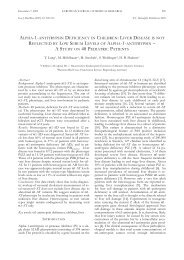European Journal of Medical Research - Deutsche AIDS ...
European Journal of Medical Research - Deutsche AIDS ...
European Journal of Medical Research - Deutsche AIDS ...
Create successful ePaper yourself
Turn your PDF publications into a flip-book with our unique Google optimized e-Paper software.
June 27, 2007 EUROPEAN JOURNAL OF MEDICAL RESEARCH<br />
97<br />
children have an increased atherogenic risk pr<strong>of</strong>ile based on<br />
either TG levels and/or sdLDL. A careful clinical follow up <strong>of</strong><br />
children on HAART is required to monitor atherogenic complications.<br />
D.45 (Poster)<br />
HIV or ART? Gender differences in the causal<br />
attribution <strong>of</strong> symptoms and adverse events<br />
Kremer H. 1 , Sonnenberg-Schwan U. 1 , Arendt G. 1 ,<br />
Brockmeyer N. 2 , Ulmer A. 3 , Graefe K. 4 , Starke W. 5 , for the<br />
German Competence Network HIV/<strong>AIDS</strong><br />
1 German <strong>AIDS</strong> Society, All Around Women Special, Bochum,<br />
Germany, 2 Ruhr-University, Clinic for Dermatology, Bochum,<br />
Germany, 3 Praxis Ulmer/Fritsch/Müller, Stuttgart, Germany,<br />
4 ifi - Institute for Interdisciplinary Medicine, Hamburg,<br />
Germany, 5 Praxis Starke, Wiesbaden, Germany<br />
Objective: This multicenter study examines differences between<br />
men and women with HIV on physical symptoms,<br />
symptom severity, and the causal attribution <strong>of</strong> those symptoms<br />
as related to HIV disease, antiretroviral treatment<br />
(ART), or other reasons.<br />
Method: A total <strong>of</strong> 163 patients (55% male, 45% female)<br />
filled in a self-report questionnaire consisting <strong>of</strong> information<br />
on their ART, a comprehensive physical symptom checklist<br />
including a rating <strong>of</strong> symptom severity and the most likely<br />
cause: HIV, ART or other/unknown reasons. Self reported<br />
laboratory abnormalities were compared to laboratory reports<br />
provided by their physicians.<br />
Results: Women and men did not differ on the means <strong>of</strong> perceived<br />
symptom severity, sum <strong>of</strong> symptoms (28 ±15), and<br />
percentage <strong>of</strong> symptoms attributed to ART (27 ±22%). However,<br />
men attributed their symptoms significantly more <strong>of</strong>ten<br />
to HIV than women (25 ±23% vs. 16 ±20%, p = .01) and less<br />
<strong>of</strong>ten to other/unknown reasons (47 ±28% vs. 58 ±27%, p =<br />
.02). In contrast, women were significantly more likely to attribute<br />
laboratory abnormalities to ART (p = 0.04) and to discontinue<br />
Kaletra due to side effects (p = .03). Conversely,<br />
men were significantly more likely to take Kaletra than<br />
women (p < .01) and to have elevated triglycerides (p = .01).<br />
Overall, patients reported only between 5 to 30% <strong>of</strong> the detected<br />
laboratory abnormalities. There were no gender differences<br />
on awareness <strong>of</strong> laboratory abnormalities, except for<br />
women being significantly more likely than men to be aware<br />
<strong>of</strong> elevated creatinine levels (p = .02) and to change ART due<br />
to elevated creatinine levels (p = .02).<br />
Conclusions: Results suggest that people with HIV attribute<br />
about half <strong>of</strong> their symptoms neither to HIV nor to ART. The<br />
finding that men are more likely than women to relate their<br />
symptoms to HIV may have implications for the motivation to<br />
remain on the same ART regimen, even if side effects occur.<br />
In contrast, women may be more prudent in avoiding side effects<br />
<strong>of</strong> ART. The striking lack <strong>of</strong> awareness <strong>of</strong> laboratory abnormalities<br />
in both men and women may indicate a potential<br />
gap in physician-patient communication. The causal attributions<br />
<strong>of</strong> physical symptoms and laboratory abnormalities differ<br />
between men and women, which has implications for clinical<br />
practice and research.<br />
D.46 (Vortrag)<br />
Der Uridin-Spiegel im Plasma korreliert mit<br />
klinischen und laborchemischen Markern der<br />
mitochondrialen Toxizität<br />
Eckert R. 1 , Schirmer D. 1 , Winzer R. 1 , Heinz W. 1 ,<br />
Leyh M. 1 , Guhl C. 1 , Klinker H. 1 , Langmann P. 2<br />
1 Medizinische Klinik und Poliklinik II der Universität<br />
Würzburg, Schwerpunkt Infekiologie, Würzburg, Germany,<br />
2 Praxis für Gastroenterologie und Infektiologie, Karlstadt,<br />
Germany<br />
Hintergrund: Mitochondriale Toxozität wird unter anderem<br />
durch Hemmung der DNA-Polymerase g vermittelt. Experimentell<br />
konnte gezeigt werden, dass das Nukleosid Uridin<br />
diese Toxizitätseffekte verhindern kann.<br />
Fragestellung: Im zeitlichen Verlauf sollte an einem größeren<br />
Kollektiv untersucht werden, ob die Uridinspiegel mit<br />
klinischen Befunden unter ART, mit der ART oder Nebenwirkungen<br />
korrelieren.<br />
Methodik: Messung der Uridinplasmaspiegel erfolgte mittels<br />
HPLC und UV-Detektion. Von 182 HIV-Patienten (m/w:<br />
137/45; Durchschnittsalter: 41 Jahre) wurden Spiegel bestimmt,<br />
per T-Test analysiert und mit klinischen und laborchemischen<br />
Parametern korreliert.<br />
Ergebnisse: Patienten im CDC-Stadium C (n=33) hatten mit<br />
5,28±1,68mol/l einen deutlich niedrigeren mittleren Uridinspiegel<br />
als Patienten im Stadium A (n=98, 6,19±1,9mol/l)<br />
und B (n=51, 6,36±2,2mol/l).<br />
Bei Patienten, die dideoxy-NRTIs erhielt (n=43), fanden<br />
sich die niedrigsten Uridinspiegel der 4 Therapiegruppen (mit<br />
dideoxy-NRTI, NRTI, NRTI-frei, ohne Therapie) mit einem<br />
MW von 5,7±1,63mol/l.<br />
Der Uridinspiegel der Patienten, die mit NRTIs, aber ohne<br />
dideoxy-NRTIs behandelt wurden (n=111), betrug<br />
6,15±2,13mol/l und war bei den Patienten ohne NRTIs (n=7)<br />
im Mittel bei 6,34±2,74mol/l. Patienten ohne ART (n=21)<br />
wiesen die höchsten Uridinspiegel auf (6,53±1,55mol/l).<br />
Dabei waren die Werte therapienaiver Patienten (n=16) mit<br />
6,39±1,66mol/l im Vergleich zu Patienten in Therapiepause<br />
(n=5) mit 6,99±1,14mol/l erniedrigt (p>0,05).<br />
Während sich unter dideoxy-NRTI ein Abfall im Therapieverlauf<br />
nachweisen ließ, zeigte sich im Verlauf der HIV-<br />
Erkrankung ohne Therapie tendenziell ein Anstieg der Uridinspiegel.<br />
Auch Therapie mit non-dideoxy-NRTI führte im Verlauf<br />
(1,5 Jahren) zu einem leichten Anstieg der Uridinspiegel.<br />
Klinische Befunde wie Fettleber und Auftreten eines Diabetes<br />
mellitus waren ebenfalls mit niedrigen Uridinspiegeln korreliert.<br />
Schlussfolgerung: Die Korrelation des Uridinspiegels mit<br />
klinischen Befunden der mitochondrialen Toxizität zeigt<br />
sowohl hinsichtlich der Therapie als auch für den zeitlichen<br />
Verlauf eine schlüssige Übereinstimmung. Ob unter Substitutionstherapie<br />
eine inverse Korrelation von Uridinspiegeln und<br />
Reversibilität von Toxizität zu sehen ist, sollte genauer untersucht<br />
werden.





